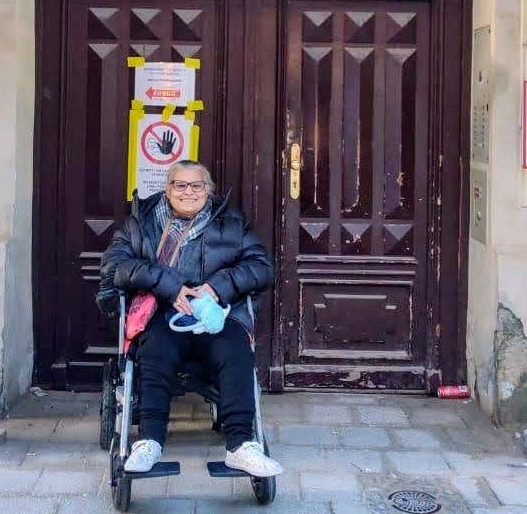OBITUARY
Anita Ghai (1958-2024): Critical disability studies scholar and activist
Rachana Johri
Published online first on December 21, 2024. DOI:10.20529/IJME.2024.087
It has been just over a week since I received the news that my dear friend Anita Ghai was in the ICU. The next day she had left us. I had known Anita for over four decades since our days as undergraduate students of Psychology at Indraprastha College. Knowing Anita was a transformative experience. It was through our many conversations that I began to have some sense of living with a disabled body in an ableist world.
Anita had lived with polio since she was a child. But this was the visible disability the world could see. In addition, she survived two heart surgeries, cancer and a stroke. Her relationship with medicine was probably a response to these two distinct yet overlapping aspects of her experience. As a survivor of health-related issues, she relied on modern medicine. But for Anita, this became an opportunity for a critical rethinking of the medical model and the ideology of cure. She wrote extensively about the damage done by attempts at cure, where in fact it is the acknowledgement of difference that is required.
Anita was the author of three significant books, (Dis)Embodied Form: Issues of Disabled Women (2003), Rethinking Disability in India (2017) and Disability in South Asia: Knowledge and Experience (2019) and numerous other writings. Her path breaking work centred on her experience; personal, embodied yet located within the social, cultural and political context of India. She engaged with and drew extensively from western theory but critiqued the focus on autonomy espoused by some western writers. Her writing challenged the binary of autonomy/dependence making space for the vision of a world characterised by interdependence. While disability was often her point of entry, her contributions extended to the fields of education, health, bioethics, gender and sexuality studies.
Our friendship and collaborations grew out of our shared training in the discipline of Psychology. Anita taught Psychology for over two decades at Jesus and Mary College. By the 1990s, she had turned towards researching the experience of disabled girls. She began to question the latent commitments of positivist Psychology including evolutionary theory and the selection of the fittest, mind-body dualism and the measurement of differences. Anita gradually turned away from the psychological construction of disability as the individual limitation of a “handicapped” and diseased individual who was fundamentally a misfit in the world and required rehabilitation.
In search of politics that could include her lived experience, Anita turned both to the disability movement and the Indian women’s movement. She found that the disabled woman was excluded by both. The disability movement rarely addressed patriarchal violence while the women’s movement failed to consider the simultaneous presence of discrimination, invisibilisation and neglect in the lives of disabled women. The problem seemed to be that the disabled woman was thought to be asexual, outside the institution of marriage and incapable of reproduction, rendering her a non-woman. Yet, Anita saw the shared critique of hegemonies as the basis of an intuitive connection with the women’s movement. In the conversations that took place at various conferences of the Indian Association for Women’s Studies (IAWS), disability emerged as a part of the vision of the IAWS with Anita as the President between 2008-11.
Knowing her and reading her work was a destabilising experience. Those who came across her thoughts experienced a paradigm shift from the perspective of an able-bodied subject to one who was temporarily able bodied (TABs). It was also met with resistance for creating existential and aesthetic anxieties, taking away as it did the illusion of permanence, and the immunity from becoming the “abject object” represented by the disabled body. She taught me and many others to scrutinise public spaces, whether libraries, classrooms, public transport or toilets from the perspective of accessibility.
Given her framing of the field of disability as characterised by an “epistemology of ignorance”, she had long “dreamt” of setting up an interdisciplinary Programme in Disability Studies in an Indian University. In 2015, she joined the School of Human Studies at Ambedkar University Delhi (AUD) as Professor, Disability Studies. At AUD, she created courses for students at all levels and after some struggle, a doctoral programme in Disability Studies. Anita was also on the editorial board of several journals. In 2020, she along with colleague and friend Tanmoy Bhattacharya, established the Indian Journal of Critical Disability Studies.
Anita lived a life of tremendous pain, both physical and psychological. Yet she was a woman of exemplary courage with a great capacity for joy. She was a regular presence at protests in Delhi and was vociferous in her support for the marginalised. In what were to be the last months of her life, she was intensely engaged in a reflection on Buddhism and disability, perhaps in search of new answers to the complexity of her existence. As always, she read extensively, interviewed practitioners and attempted to incorporate aspects of Buddhist practices into her life. This was her way of living, where work and life were closely intertwined.
Anita wanted a life of both joy and justice. Her most lasting contribution was to ask difficult questions, to confront and challenge, and to ask for a better world. This is the legacy for us, activists and academics to take forward.
Author: Rachana Johri (rachanajohri@gmail.com), Visiting Professor Psychology, School of Liberal Studies, BML Munjal University, Haryana, INDIA
To cite: Johri R. Anita Ghai (1958-2024): Critical disability studies scholar and activist. Indian J Med Ethics. 2025 Jan-Mar; 10(1) NS:81-82. DOI:10.20529/IJME.2024.087
Published online first: December 21, 2024
Copyright and license
©Indian Journal of Medical Ethics 2024: Open Access and Distributed under the Creative Commons license (CC BY-NC-ND 4.0), which permits only noncommercial and non-modified sharing in any medium, provided the original author(s) and source are credited.